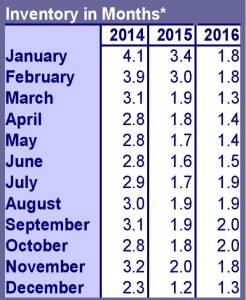
TMREI: Too Much Real Estate Information
Sometimes absorbing the sea of Oregon real estate information is more like drinking from a fire hydrant. Yet, out of all the seemingly helpful real estate data bandied about, there is one especially helpful number, which when understood, can provide near-magical clarity to both homebuyers and homesellers.

What Is It?
What is this ‘magic’ number and what does it represent? Simply put, it’s the current figure for housing inventory, typically expressed in months of projected home supply.
Oregon Real Estate's Magic Number - Download This Episode
Listen to the audio podcast presentation of this helpful program on Oregon real estate by clicking here or on the above link.

Housing inventory is also sometimes known as home inventory or housing backlog. Why is this number so important? Once you understand the single figure that defines our current supply of local available Oregon homes for sale, you have an instant ‘snapshot’ on whether you’re in a buyer’s market, seller’s market, or more of a balanced real estate market. Armed with that information, you’re far more ready to do battle in the real estate trenches and more likely to avoid some usual minefields.
Normal Home Supply
Among real estate experts, a ‘normal’ range for home supply in parts of Oregon is frequently cited as somewhere between three to six months. For example, if the home supply figure is three, then hypothetically our market would be ‘out of homes’ in three months, provided no new homes were placed for sale. In other words, if our regional home inventory figure is within three to six months, we’re typically experiencing a normal market, meaning one not far from a balance of supply and demand, also called equilibrium. In a way, it’s kind of like an absorption rate for how fast supply is used up.

Your Mileage May Vary
It’s helpful to understand that home inventory figures are more of an average for a region. In Oregon, major real estate regions include Portland, Bend, Eugene, Salem and the Oregon Coast. So if your property is located in Beaverton, you’re likely to use the Portland area figure as the bellwether for housing backlog. If your home is located in Keizer, you’re likely to see the Salem inventory figure as the closest approximation of local home supply. It’s also likely that your specific area could be somewhat different altogether, based on a variety of hyper-local factors affecting both demand and supply. That said, home inventory is a convenient ‘thumbnail’ sketch to help assess what kind of market you’re in.

What’s The Practical Impact of Housing Inventory?
Consider real estate and inventory like a pipeline. If more flows through it, the product is plentiful and therefore the cheaper it is to buy. So with a lower, dwindling home supply and the spigot turned down, the reverse is true. That’s when the local real estate environment favors sellers, because there are more buyers and it’s considered a ‘seller’s market.’ In that case, expect a short market time and an environment where homesellers receive multiple offers, often at or above listing price. If the supply of homes is higher, it’s considered a ‘buyer’s market.’ This means you can expect a longer market time, with homesellers seeing few, if any offers…and frequently for less than the asking price.

It’s routinely a good idea for buyers to get a ‘heads up’ before making an offer to determine how ‘hot’ or ‘cold’ the market is. Otherwise, if you ‘lowball’ a just-listed home in a seller’s market, you may be lucky to even get a counteroffer instead of an outright rejection by sellers experiencing lots of calls and showings on their property. Coming in with an offer that’s too low sometimes causes offended sellers to refuse to seriously consider a possible follow up offer.

What’s the Big Deal About Housing Inventory?
One reason housing inventory is so important is because it helps buyers and sellers to better manage expectations. Most buyers are interested in how long it may take to find the ‘right’ house. Inventory affects this. Alternatively, most sellers are interested in how long it may take to find a qualified buyer. Inventory affects this, too.

That’s because a high home inventory tends to slow down the market time and low inventory frequently provides a ‘jump start’ to activity. One way sellers can help to avoid an excessively long market time is to review comparable local home sales information provided by their Realtor to ensure proper, market pricing.
Another reason housing inventory is crucial is because it can significantly impact so many other important factors. In other words, inventory is a ‘driver’ for market time, selling price, appraisal results, lendability and more.
Okay, So Inventory Is Important. What Does It Look Like?

The above image provides a good example of fluctuating home inventory. As Oregon’s real estate market bounced back from the severe market downturn of the Great Recession, the home inventory for some areas reduced from more than 20 months of housing supply to less than three.

Contact the Experts
Thinking about selling your Oregon property? Know the market before diving in! Call Certified Realty with your questions and for a free consultation on what your property could sell for today at (800) 637-1950.